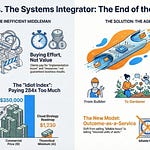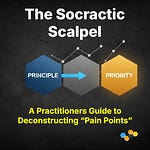Introduction: The End of an Era – The Silent Revolution in Sales
Let's be honest. Take a hard look at your sales stack. You’ve got your CRM, the sun around which everything is supposed to orbit. Then you have the planets: your sales intelligence tool, your engagement platform, your forecasting software, your conversation intelligence, your e-signature tool. Each was bought with a promise—a promise of more efficiency, better data, and ultimately, more revenue.
Yet, if you’re like most sales professionals, you feel the drag. You're drowning in a sea of tabs, fighting with data sync issues, and spending hours on administrative work that feels suspiciously like the very inefficiency you were promised you'd escape. This feeling isn't just in your head. It’s a sign that the current paradigm is broken. The tools are no longer working for you; you're working for them.
This state of "CRM fatigue" and tool sprawl isn't just a feature of modern sales; it's a symptom of a much deeper issue. You're working at the wrong level of abstraction. The first great abstraction in sales was the invention of Sales Force Automation (SFA) and the CRM, which heroically bundled the chaotic, paper-based processes of the past into a single, manageable platform. For a time, it was a massive leap forward, fundamentally changing the job of selling, elevating it to a new level of abstraction.
But that era is over. We are now on the cusp of a second, more profound abstraction. This new wave won't just add another feature or a slicker UI. It will fundamentally change the nature of the work. It will make today's CRM-centric workflow, with its endless integrations and manual data entry, seem as archaic as a Rolodex and a fax machine. This isn't just about new tools; it's about a profound shift in mindset – moving from simply selling products to orchestrating the successful completion of a customer's desired "job-to-be-done."
This post will break down how that first abstraction happened, the critical new problems it created, and—using a systematic framework for innovation—show you what the next abstraction will look like. It's time to stop looking for a better CRM and start preparing for its extinction.
Part 1: The First Great Abstraction – Sales Force Automation (SFA) and CRM
To understand where we're going, you have to appreciate where we've been. Before the 1990s, the core functional "Job-to-be-Done" for a salesperson was largely the same as it is today: Securing Revenue by Guiding a Prospect from Awareness to Purchase.
The Job Before the Machine: Selling in a Pre-Digital World
Before the digital revolution, the work of sales was a masterpiece of disconnected, manual processes, each with its own physical artifact. The core job-to-be-done for these sales professionals was primarily Building and Maintaining Customer Relationships. This involved everything from remembering client preferences to tracking follow-up dates on a desk calendar.
The key activities included:
Managing Contacts: The legendary Rolodex, a spinning file of cards that was a salesperson's most prized possession. Losing it was catastrophic.
Tracking Activities: Day-planners, notebooks, and binders filled with handwritten notes about calls, meetings, and follow-ups. There was no single source of truth.
Forecasting: A dark art combining gut feelings, intuition, and maybe a manually updated spreadsheet if the salesperson was particularly organized.
Generating Reports: A heroic effort of manual data assembly, pulling information from various paper sources to give management a vague picture of the pipeline.
The "struggles" were immense and baked into the very fabric of the work. It was brutally inefficient, with salespeople spending a huge portion of their day on low-value administrative tasks. For sales leaders, there was almost zero visibility into team activity or pipeline health. The data was inconsistent, often lost, and scaling a sales team meant trying to duplicate an unwritten, analog process—an almost impossible task.
The Rise of SFA/CRM: Automating the Mundane, Enabling the Strategic
Then came the revolution: Sales Force Automation (SFA) and its evolution into the Customer Relationship Management (CRM) system. Platforms like Siebel and eventually Salesforce didn't just offer a digital Rolodex. They created a new, higher level of abstraction.
They took the disparate, chaotic tasks of selling and bundled them into a single, cohesive software platform. Suddenly, contact management, activity tracking, and reporting were all connected. For the first time, sales leaders had a real-time, consolidated view of the pipeline. SFA was a "Core Platform" innovation that helped the Current Job Executor—the salesperson and their manager—get the core job done better, faster, and more predictably. It abstracted away the messy, low-level work of managing paper and gave salespeople more leverage.
The core job was refined from simply "building relationships" to Managing Customer Interactions and Forecasting Revenue (functional). You see, SFA and CRM lifted sales teams out of the weeds of manual data entry and provided a bird's-eye view of the entire customer journey. This freed up mental and physical bandwidth. The focus shifted from the act of logging a call to the strategy behind managing a relationship across multiple touchpoints. You moved from being a data entry clerk to a strategic orchestrator of customer engagement. The benefits were undeniable. Sales cycles became more efficient. All customer data, from initial contact to post-sale support, was centralized, providing a 360-degree view. Teams could collaborate seamlessly, sharing notes and insights. Forecasting, while still imperfect, became far more data-driven. This fundamental shift allowed businesses to scale their sales efforts, improve customer satisfaction, and gain unprecedented insights into their market.
The Platform Paradox: When the Solution Becomes the Problem
But here's the crucial point that the history books often miss: in solving one set of problems, the first abstraction created a new, more sophisticated set of them. This new platform, for all its power, was not a panacea. It left behind critical gaps that would come to define the next two decades of sales technology.
The Data Entry Burden: The system's greatest strength—its centralized database—was also its greatest weakness. It was empty by default. This created a new, uncompensated job for the salesperson: continuously feed the system with data. Every call, every email, every meeting had to be logged. This shifted a huge portion of their time away from the customer-facing work of selling and toward the internal-facing work of administration. The CRM became a repository that demanded constant feeding, often without clearly telling you what to do next without significant manual analysis.
The Process-Centric Worldview: SFA and CRM systems are built around the seller's process, not the buyer's reality. They forced the messy, non-linear, human journey of a purchase decision into a rigid, linear set of stages (e.g., Lead, Qualification, Proposal, Negotiation). This provided a common language for management but was often completely disconnected from the customer's actual, meandering path to a solution.
The Illusion of Insight: The new platform gave leaders unprecedented visibility into activity. They could see how many calls were made, how many emails were sent, and how many meetings were held. But it couldn't tell them if these were the right activities, or if those activities were leading to the desired customer outcomes. It created a massive gap between tracking effort and understanding impact, leading to a generation of management focused on activity metrics over true outcome metrics. Your CRM is brimming with data, but extracting actionable intelligence can feel like mining for gold with a spoon.
Nature abhors a vacuum, and so does the market. An entire ecosystem of software companies emerged to plug the gaps created by the CRM.
The Data Entry Burden led to sales engagement platforms (like Outreach, Salesloft) that automated email sequences and logged activities, and conversation intelligence tools (like Gong, Chorus) that recorded calls.
The Process-Centric Worldview led to buyer-enablement tools that tried to create a better external-facing experience.
The Illusion of Insight led to a wave of business intelligence and forecasting tools that promised to make sense of the mountains of (often dirty) activity data inside the CRM.
And so, the paradox was born. The CRM, the elegant platform that was created to bundle chaos into a single system, became the bloated, complex hub of a dozen other "patch" solutions. The salesperson, who was freed from the Rolodex, was now shackled to a digital monstrosity.
The job has changed again. For salespeople, the Job-to-be-Done has become Managing the Sales Stack Instead of Guiding the Prospect. They struggle constantly with context switching, tool fatigue, and the nagging feeling that they spend more time managing software than talking to customers. For leaders, the Job-to-be-Done is now Interpreting Data from a Dozen Disconnected Systems. They struggle with astronomical software costs, abysmal data hygiene, and a frustrating inability to get a clear, predictive view of the business.
The first abstraction has reached its limits. The solution has become the problem. It's time for the next leap.
Part 2: The Second Great Abstraction: A New Value Delivery Platform for Sales
The next evolution won't be a "better CRM." It won't be another integration or a new feature. It will be a "New Value Delivery Platform"—a fundamentally different way of getting the job done that makes the old way obsolete. This new platform will have far fewer visible features, will be powered by intelligent automation, and will be organized around outcomes, not activities. These are concepts that don't just improve existing sales processes but get the entire "job-to-be-done" in a fundamentally different way.
Here are three visions of what this second abstraction could look like, incorporating concepts that some leading-edge companies are already hinting at, alongside truly novel approaches.
Novel Concept 1: The "Invisible" AI Sales Director
Imagine you finish a sales call. You hang up. You do nothing else. You don't open the CRM. You don't log the call. You don't update the opportunity stage. You don't schedule a follow-up task.
Instead, an intelligent agent in the background does it all. Leveraging "Proactive Opportunity Sensing" and "Autonomous Deal Progression" capabilities, it listened to the call, transcribed and summarized it, updated the forecast based on the content of the conversation, and scheduled a tentative follow-up. A few minutes later, you get a simple notification: "Based on the budget concerns raised by the prospect, I've drafted a follow-up email with the case study on Project X and proposed a meeting with a technical specialist for next Tuesday. Approve?"
How it gets the job done completely differently: In this world, the CRM as an interface is largely gone. It's been dematerialized into an invisible infrastructure layer. The salesperson's primary job is no longer data entry and process management; it's high-value human interaction. The platform automatically performs the decision-making of a sales manager or a highly efficient junior sales rep, serving up the next best action required to move the deal forward. The salesperson's new role is to execute those high-value actions and provide strategic oversight. This transforms the human effort from administrative execution to strategic validation and interpersonal influence.
Fewer Visible Features: The complex array of dashboards, input fields, and manual triggers in a traditional CRM disappears. You interact primarily with a streamlined notification system, asking for approvals or prompting for critical human-only interventions. The underlying sophisticated AI and data processing are entirely obfuscated.
Lower Cost: The dramatic reduction in manual administrative time for sales professionals translates directly into lower operational costs and higher per-rep productivity. The system ensures consistent, optimal progression of opportunities without the variable costs of human oversight for every single step.
Creativity Trigger Analysis:
From Innovation Matrix:
Automating processes.
Eliminating manual tasks.
Making something physical "virtual" (Inputs/Outputs dimension) by creating virtual sales assistants.
Filtering and Aggregating information (Information dimension).
Foreseeing (Experiential Verb) demand.
Anticipating (Experiential Verb) needs.
From Marketing Matrix:
Make the platform automatically perform decision-making activities.
Conceal platform infrastructure that does not need to be visible.
Borrow available resources and make them part of the platform.
Novel Concept 2: The Outcome-Centric Buyer Platform
Today's CRM is built around the seller's pipeline. But what if the platform was built around the buyer's Job-to-be-Done? This concept leverages principles of "Hyper-Personalized Buyer Journeys."
Concept: This novel concept envisions a shared digital workspace between the buyer and the seller. It's not a sales pipeline; it's a mutual action plan. The platform is organized entirely around the key outcomes the buyer is trying to achieve. All communication, resource sharing (proposals, case studies, technical docs), and stakeholder management happen in this single, transparent environment.
How it gets the job done completely differently: The system tracks progress against the buyer's desired outcomes, not the seller's internal stages. This changes the entire dynamic from a potentially confrontational "us vs. them" process to a collaborative journey. It might even enable a "New Job Executor"—a "deal conductor" or "collaboration manager" whose primary skill is not persuasion, but project management and outcome delivery. This fundamentally shifts the sales process from a linear, seller-driven funnel to a flexible, collaborative, and outcome-focused partnership.
Fewer Visible Features: The clutter of internal sales reporting, activity logs, and separate communication tools disappears for both parties. The interface is streamlined around shared objectives, progress tracking against those objectives, and collaborative document management. The "selling" process is so integrated into the "buying" process that it becomes almost indistinguishable, simplifying the entire interaction.
Lower Cost: By minimizing communication overhead, reducing manual data reconciliation, and accelerating the decision-making process through transparency and shared accountability, the cost of both buying and selling is significantly reduced. Less time spent on administrative tasks means more time on value creation.
Creativity Trigger Analysis:
From Innovation Matrix:
Changing and Varying Proportions (Size/Scale/Shape dimension).
Adapting the entire experience (Experiential Verb).
Removing platform infrastructure that is not needed to get the job done.
From Marketing Matrix:
Customizing the sales process.
Make the platform virtual.
Construct the platform so that it allows third parties to add features or content over time.
Remove platform infrastructure that is not needed to get the job done.
Novel Concept 3: The Autonomous Deal-Making Protocol
This is the most radical vision, but it's a logical endpoint for many types of sales, leveraging advanced "Autonomous Deal Progression" capabilities.
Concept: For transactional, product-led, or high-velocity sales, the human element can be abstracted away almost entirely. Imagine a world where your company is represented by an AI agent, and your prospective customer is also represented by an AI agent. The buyer's agent has a defined set of needs, constraints, and desired outcomes. Your agent has a set of products, pricing rules, and negotiation parameters.
How it gets the job done completely differently: These two agents meet in a secure digital space. They negotiate terms, execute the transaction via a smart contract, and provision the service—all without direct human intervention. The deal happens autonomously, 24/7. The role of the human sales team shifts dramatically from execution to strategy: designing the rules, pricing models, and negotiation playbooks that the autonomous agents will use. This is a complete redefinition of the "salesperson" role, from direct operator to strategic architect.
Fewer Visible Features: From the user's perspective (both buyer and seller), the negotiation and transaction process becomes almost entirely invisible. There are no manual forms, no phone calls, no email chains. The "features" are the pre-defined parameters and outcomes, not the steps of the process. The customer just experiences the provisioning of the solution they needed.
Lower Cost: The elimination of human touchpoints for the transaction itself drastically reduces labor costs associated with high-volume, low-complexity sales. The 24/7 autonomous operation ensures maximum efficiency and speed, further lowering the cost per transaction and enabling massive scalability that would be impossible with human-led sales.
Creativity Trigger Analysis:
From Innovation Matrix:
Automating processes.
Removing human intervention.
Making something physical "virtual" (Inputs/Outputs dimension) by creating virtual sales agents.
Inverting cause and effect (Operation) as the outcome drives the autonomous action.
From Marketing Matrix:
Make the platform automatically perform physical activities.
Construct the platform to eliminate downtime in the execution of the job.
Create a new platform to execute a portion of the job that is performed inefficiently on the core platform.
Conclusion: Prepare for Dematerialization – The Journey to True Customer Obsession
The history of technology is a history of abstraction. We went from manually switching telephone lines to dialing numbers to simply asking our phones to call someone. At each step, the underlying complexity was hidden, and the tool became more powerful and easier to use. Sales technology is on the exact same path.
We went from the manual chaos of paper to the first abstraction of the CRM, which solved huge problems but created new, insidious ones around data entry and process rigidity. We are now living in the painful collapse of that first abstraction, drowning in a sea of apps designed to patch its flaws.
The second abstraction is coming, and it's a dematerialization. It will make the sales stack invisible. What you'll see isn't just a "better CRM"; it's the end of the CRM as you know it. The focus won't be on logging activities, managing processes, or feeding a database. It will be on orchestrating intelligent systems, collaborating deeply with customers, and achieving outcomes.
The sales function won't disappear; it will evolve to become a strategic orchestration of value, often invisible to the customer because the solutions simply work to get their jobs done. By embracing this mindset, you won't just improve your sales; you'll redefine your entire business around true customer obsession. The imperative for you and your organization is clear: Don't get stuck in the current paradigm. While SFA and CRM are powerful tools, they represent only the first major leap. The future of sales isn't about more complex software; it's about simpler outcomes. It's about AI anticipating needs, systems dynamically orchestrating solutions, and business models aligning perfectly with customer success.
I've outlined three possible futures, but what do you think? What's the biggest struggle with your current sales stack that a new level of abstraction needs to solve? Share your thoughts in the comments.
Follow me on 𝕏: https://x.com/mikeboysen
If you'd like to see how I apply a higher level of abstraction to the front-end of innovation, please reach out. My availability is limited.
Mike Boysen - www.pjtbd.com
Why fail fast when you can succeed the first time?
📆 Book an appointment: https://pjtbd.com/book-mike
Join our community: https://pjtbd.com/join












